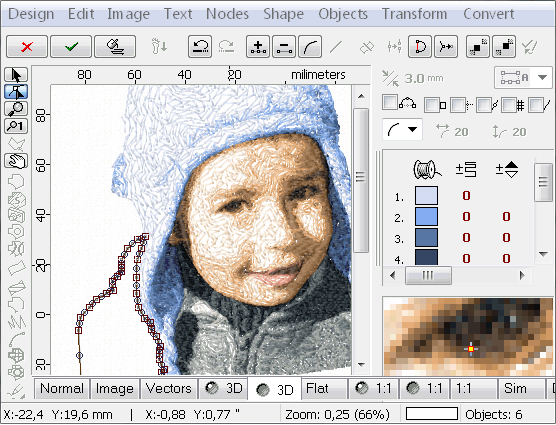Reputable Digitizing for Embroidery: Relied On by Experts
Reputable Digitizing for Embroidery: Relied On by Experts
Blog Article
Grasping the Needlework Digitizing Refine: Your Ultimate Overview
Needlework digitizing is a careful craft that needs precision and proficiency to translate intricate styles right into digital layouts for maker needlework. As craftsmens get started on this trip to master the needlework digitizing process, a thorough understanding of the fundamentals establishes the foundation for quality.

Understanding Needlework Digitizing Basics
Needlework digitizing basics create the structure whereupon intricate layouts are converted right into machine-readable layouts for precise stitching. This initial step in the embroidery digitizing process is important for making certain that the last embroidered item is a devoted representation of the original design. Understanding needlework digitizing essentials entails realizing vital ideas such as stitch types, sew direction, thickness, underlay, and pull payment.
Stitch kinds play a vital role in figuring out the aesthetic and textural result of the embroidered style. By selecting the appropriate stitch kind, whether it be satin, fill, or running stitch, digitizers can achieve the wanted result and enhance the overall quality of the needlework. Furthermore, sew instructions affects the flow and measurement of the style, while thickness identifies the spacing and coverage of the stitches.
Moreover, rug sewing provides stability to the style by safeguarding the textile and preventing distortion throughout the embroidery process. Pull payment is another essential consideration to combat the all-natural tendency of fabric to contract when sewn. Understanding these embroidery digitizing basics is fundamental for creating professional-quality embroidered items.
Picking the Right Digitizing Software Program
Selecting the appropriate digitizing software is a critical decision that substantially affects the performance and top quality of the needlework digitizing procedure. Digitizing for Embroidery. When selecting the appropriate digitizing software application, it is vital to consider aspects such as the intricacy of designs you plan to create, the user-friendliness of the software application, the degree of customer assistance offered, and the compatibility with your embroidery maker
There are numerous digitizing software options readily available in the marketplace, varying from standard programs for newbies to sophisticated software program for expert digitizers. Some prominent options consist of Wilcom EmbroideryStudio, Hatch Needlework Software, and PulseID. These software bundles provide a wide variety of devices and features to help you create intricate designs with ease.
Before making a decision, it is recommended to check out the various software application choices with cost-free tests or trials to figure out which one ideal fits your needs. Additionally, reading evaluations and explanation looking for recommendations from seasoned digitizers can supply important insights right into the toughness and weaknesses of each software plan (Digitizing for Embroidery). By very carefully examining your requirements and comparing the functions of various digitizing software program, you can make an enlightened selection that boosts your needlework digitizing process
Digitizing Tools and Techniques

Optimizing Layout Settings for Embroidery
Mastering the intricacies of layout setups is essential in attaining ideal results in the needlework digitizing procedure, building upon the foundation laid by recognizing digitizing tools and techniques. When maximizing layout setups for needlework, it is important to take into consideration factors such as stitch type, thickness, padding, pull compensation, and enrollment. Enrollment settings straighten various aspects of the style accurately, keeping general design honesty.

Troubleshooting Common Digitizing Issues
When coming across common digitizing problems throughout the embroidery process, it is learn this here now important to comprehend the root creates and carry out efficient services promptly. One typical trouble is stitch thickness problems, where stitches might be also thick, triggering the fabric to tighten, or too sporadic, leading to voids in the design. Readjusting the stitch density settings in the digitizing software application can help solve this issue.
One more regular obstacle is thread breaks during the embroidery procedure. This can happen as a result of numerous reasons such as wrong stress settings, plain needles, or utilizing low-grade string. Ensuring correct maintenance of the embroidery maker, consisting of regular needle changes and tension changes, can minimize the incident of string breaks.
Moreover, style enrollment mistakes can lead to misaligned components within the needlework style. Inspecting the design placement in the digitizing software application and making essential modifications prior to stitching can aid in preventing this issue. By attending to these common digitizing issues immediately and properly, you can make sure a smoother needlework process and top notch finished items.
Final Thought
To conclude, understanding the embroidery digitizing process requires a strong understanding of the essentials, the ideal option of software application, and understanding of tools and techniques. Optimizing layout setups and repairing typical digitizing problems are essential steps in making certain premium embroidery outcomes. By adhering to these steps faithfully, one can achieve accuracy and effectiveness in the digitizing procedure.
Report this page